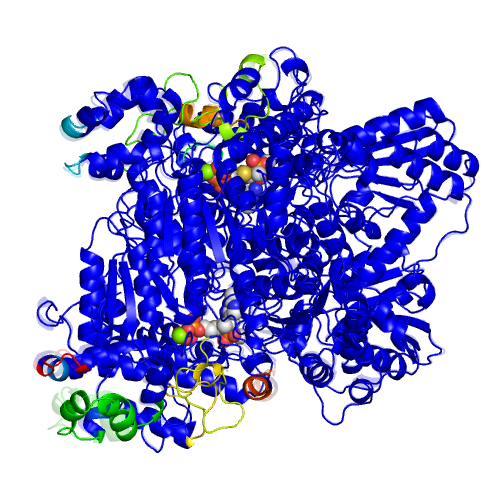CL.7 |
PYRUVATE DEHYDROGENASE E1 COMPONENT |
|
|
|
Function |
EC*1 |
CSA distance*2 |
1.2.4.1 |
2.7 |
|
*1 Enzyme commission number. |
Ligand |
PDB*1 |
Full name |
2xMG,2xTDK |
2x(MAGNESIUM ION),2x(2-PHOSPHONOLACTYLTHIAMIN DIPHOSPHATE) |
|
*1 Ligand name designated by the PDB identifiers. |
Segments |
Component No. |
Fixed*1 |
Moving*1 |
Motion type |
Ligand binding |
Coupled motion type |
1 |
D1(56A-303A,310A-326A,354A-399A,415A-526A,535A-540A,559A-886A,56B-398B,417B-526B,535B-540B,559B-886B) |
L2(541A-558A) |
Local |
Independent |
|
2 |
D1 |
L3(399B-416B) |
Local |
Coupled |
Closure |
3 |
D1 |
L4(400A-414A) |
Local |
Coupled |
Closure |
|
*1 The location of the fixed and moving segments indicated by the residue number assigned in the ligand-bound form. The background color of characters indicates the corresponding segment in the structure. The colored segments not described in the Table are: 1) a part of component in which the motion is small (< 1.0 A), or, 2) a part of a protomer of homodimers, for which a corresponding part of the other protomer is shown in the Table. |
Displacement and disorder |
Component No. |
RMSD*1 |
Displacement*2 |
Disorder-order transition*3 |
Disorder residue*4 |
Helix-Coil*5 |
1 |
Yes |
+17 |
|||
2 |
Yes |
+13 |
|||
3 |
Yes |
+13 |
|
*1 The root-mean-square displacement of a component of motion calculated for the domain motions. |

